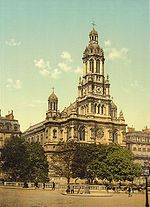La Nativité du Seigneur, neuf méditations pour orgue (The Nativity of the Lord, nine meditations for organ or The Birth of the Saviour) is a work for organ, written by the French composer Olivier Messiaen in 1935 in Grenoble.[1]

It is a testament to Messiaen's Roman Catholic faith, being divided into nine "meditations" inspired by the birth of Jesus. In volume one, Messiaen outlines his inspirations, both theological, instrumental and compositional. As the composer notes in his preface, he sought "the emotion and sincerity first".[2] The work was written by the composer at the age of 26 years during the summer of 1935 while he was in residence at Grenoble near the French Alps.[3] Messiaen wrote that in addition to theology, the movements were inspired by the mountains, as well as the stained glass windows in medieval cathedrals.[2]
The work's premiere on 27 February 1936 on the organ of La Trinité, Paris, where Messiaen was titular organist; had the work split among three players: Jean-Yves Daniel-Lesur (1–3), Jean Langlais (4–6), and Jean-Jacques Grunenwald (7–9).[3][4]
Messiaen would followup with another organ cycle, Les corps glorieux, in 1939.
Structure edit
The work is in nine movements, each depicting an image or concept from the birth of Jesus. In publication, the work is divided over four books.
- La vierge et l'enfant (The Virgin and Child), approximately 6'30"
- Les bergers (The Shepherds), approximately 7'
- Desseins éternels (Eternal purposes), approximately 6'
- Le verbe (The Word), approximately 14'
- Les enfants de Dieu (The Children of God). approximately 4'
- Les anges (The Angels), approximately 3'
- Jésus accepte la souffrance (Jesus accepts suffering), approximately 4'30"
- Les mages (The Magi), approximately 6'30"
- Dieu parmi nous (God Among Us), approximately 9'
Book I consists of the first three movements, Book II of 4 and 5, Book III of 6, 7, and 8, and IV for IX alone.
The work is one of the earliest to feature elements that were to become key to Messiaen's later compositions, such as the extensive use of the composer's own modes of limited transposition, as well as influence from birdsong, and the meters and rhythms of Ancient Greek and traditional Indian music.[1][5]
In 1967, Richard Franko Goldman wrote, "One is, indeed, tempted to say that the work is a masterpiece, and one of the great organ works of all time. It is certainly monumental and impressive, original and memorable, with or without the theoretical and mystical explanation the composer himself gives out."[6]
References edit
- ^ a b "Hommage a Messiaen/Colin Andrews". gothic-catalog.com. Retrieved 2008-12-28.
- ^ a b Messiaen, Olivier, La Nativité du Seigneur, Volume One (Paris: Ludec, 1936).
- ^ a b "Boston University Messiaen Project". Andrew Shenton. Archived from the original on 2008-12-28. Retrieved 2008-12-28.
- ^ Simeone, Nigel (Winter 2002). "In memoriam: Olivier Messiaen on Daniel-Lesur". Musical Times. Archived from the original on 2005-09-08. Retrieved 2008-03-10.
- ^ "Olivier Messiaen La Nativité du Seigneur". Hauptwerk: Music and Sound. Retrieved 2009-01-04.
- ^ Goldman, Richard Franko, "Review: Simon Preston's recording of La Nativité du Seigneur" in The Musical Quarterly, Vol. 53, No. 2 (April 1967), pp. 290-293.
External links edit
- La Nativité du Seigneur (with synchronised score), played by Olivier Latry